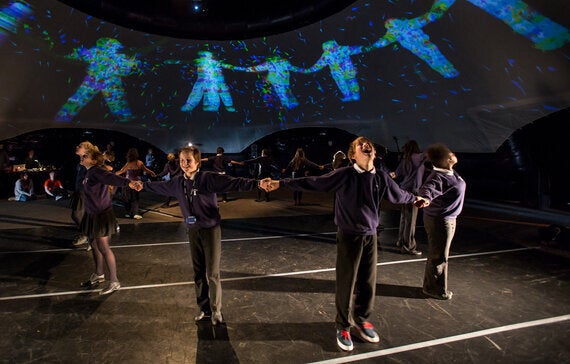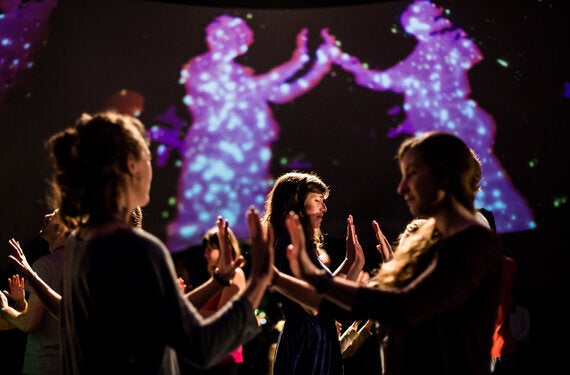
"All the many things in the universe are appearances of collections." These ancient words, attributed to the Buddha nearly 2500 years ago, resonate strongly with the recent Nobel Prizes in medicine, chemistry, and physics - which recognize advances in our understanding of how tiny things are composed of even tinier things. In medicine, the prize was awarded for understanding the dynamic transport systems used by living cells. Cells are collections of molecules, and the chemistry prize recognized the development of detailed computer models explaining how molecules work (nearly 100,000 times smaller than cells). Molecules are collections of atoms, and the physics prize was awarded for the theory that led to discovery of the Higgs boson, helping us understand the fabric of an atom.
These awards highlight two general lessons that modern science teaches us about nature. First, lots of the mechanics that drive nature occur on a scale that is very small - invisible to our human sense perception. Second, the invisible world is dynamic. No matter how many textbook pictures you may have seen of cells, molecules, and atoms, they're misleading. Tiny things are actually dynamic and perpetually changing. They are engaged in a delicate dance that depends on how their energy fields interact with their surroundings.
Understanding the invisible dances taking place on tiny scales in nature has profound impacts for our everyday lives. For example, understanding the dances of cells, molecules, atoms, and electrons allows us to make strides developing important technologies in areas like medicine and mobile communications. The same understanding also provides detailed insight into the dramatic impact that our modern lifestyles have on the planet and its atmosphere. For example, the vibrational dance of a CO2 molecule might be invisible, but it's the reason that CO2 is an effective greenhouse gas, leading to visible planetary changes like forest fires, melting ice, and rising sea levels.
Science is continually seeking out simple and effective ways of thinking about, visualizing, and explaining the way that the natural world works. For the invisible world that we cannot see, this is a real challenge, requiring the active engagement of our imaginations. Modern science is increasingly able to understand and manipulate matter at the atomic scale, with the result that the invisible layers of nature have an increasing impact on our lives in the realm of the visible. Consequently, I think that we need to cultivate an awareness of nature's invisible dances, both as individuals and as a culture. It's fascinating to imagine what might come about through this sort of heightened awareness of the invisible.
For example, what if we could see ourselves inhaling the same atmospheric gas molecules exhaled by trees? What if our naked eyes could see the dance of atmospheric CO2 molecules as they soak up heat energy from the sun? What if we could see the similarity in atomic compositions of our bodies, a river, and a flower? What if we could see the delicately correlated dances of tiny atoms in the air, and how they responded to our own energy fields?
Developing an intuition for the invisible and a sensitivity to the small is not something which science can accomplish on its own; it will require engagement with a wide range of disciplines spanning media, technology, art, psychology, communications, etc. My own attempts to increase people's sensitivity to the invisible have involved collaborations with a wide range of specialists, including a digital artist, a composer, a music technologist, a choreographer, and even modern dancers. Together we have crafted an experience called 'danceroom Spectroscopy' (dS) which fuses molecular physics, computer science, generative music, 3d imaging, and dance.

Spectroscopy refers to a set of tools that scientists use to 'see' the invisible. The underlying idea driving dS is this: on a fundamental level, we are essentially fancy energy fields. This simple idea is perhaps one of the most profound conclusions we can draw from modern science's understanding of the invisible world. On a fundamental level, the microscopic atomic and molecular interactions we have with our environment are energetic. Using physics-based molecular models, real-time supercomputing, and digital artistry, dS gives you a glimpse of your energy field embedded in a sea of atoms and molecules. As you move, your energy field interacts with these atoms and molecules, affecting their vibrational dance, and generating sound and image. It's actually not so different from what's happening to you as you sit reading this article: trillions of invisible atmospheric molecules are microscopically battering you and momentarily interacting with your energy field at the point of impact.
We've used dS to show people the atomic dynamism of the atomic world in a range of contexts, spanning education, art, and technology. Seeing themselves as fields, on equal footing with every other force in nature, children and adults alike quickly lose themselves and play in the atomic world. We've even used the dS technology to make a dance performance entitled "Hidden Fields", which encourages us to imagine those hidden energy matrices and atomic dances that form the fabric of nature, but are too small for our eyes to see. It's an invitation to contemplate the interconnected dynamism of the natural world - from the microscopic to the cosmic - and hopefully an inspiration for more attempts to help us develop a sensitivity to the increasingly visible invisible.
Award winning danceroom Spectroscopy (dS) is a new interactive visualisation of the nano-world developed at the Pervasive Media Studio through a collaboration led by Dr David Glowacki, a chemical physics researcher. It was recently presented by University of Bristol and Watershed at Brunel's Old Station in Bristol 24 - 26 October: www.watershed.co.uk/danceroom